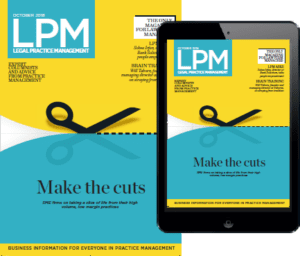
How to deliver quality client service
The future of legal services lies in a better client experience, according to Osprey Approach’s CEO Chris Pucci – who presents ways for firms to deliver consistency and quality in service.
Legal software solutions are designed around features and functionality that streamline, enhance, and improve a firm’s performance. Fee earners are tasked with driving long-term efficiencies, increasing billable hours, and onboarding new clients, all to increase profits for the firm. This is why legal tech looks to reduce manual admin, increase productivity, and introduce automation in order to help fee earners maximise their time.
All too often, the most important part of a firm’s success is overlooked – the client. Increasing efficiencies to improve profitability is crucial for a firm’s success but without attracting and retaining clients, the longevity of your firm is at risk.
With practice and case management solutions (PCMS) increasingly becoming the norm – as firms realise that traditional, manual processes are costing them – it’s not the tech alone that will help you stand out from the crowd, but your client service. Quality client service will always be a key competitive advantage, so focusing your strategy on being client-focused will help you stand out above the crowd.
The importance of quality client service
Clients have high expectations of the legal services you provide, which is why it’s important that firms have the technology and processes in place to deliver a seamless, cost-effective, digital experience, to ensure you stay competitive.
Your average consumer does not have the qualifications or knowledge to understand the complexity of the legal services you provide. They will not know if you utilised every area of the law to win/progress their case, or whether another lawyer could have done a better job. But what they do understand is what quality customer service looks like and how a good client experience makes them feel, and that’s how they will measure and value the services you deliver.
In the case of law firms, and many other professional services, the benchmark for quality customer service is set incredibly high. Every day, your clients are tapping into exceptional, real-time consumer experiences from brands who are pushing the boundaries on what it means to be client centric. Market leaders like Amazon, Uber, and Deliveroo, are removing pain points for clients that they had previously learned to accept, therefore emphasising what it means to go above and beyond for your customer.
How to exceed client expectations
With expectations set so high, it can feel overwhelming for law firms to know how to implement the right strategies to improve client satisfaction. Often, this means that firms continue with the way things have always been done in a bid to get through the volume of work. But, with over 80% of respondents to the Legal Services Consumer Panel survey saying the reputation of a firm was the top factor considered when choosing a lawyer, offering quality customer service is now more important than ever to help you stay competitive. There’s a wealth of information on how to exceed client expectations in our guide, which can be downloaded here.
The best client-focused strategy that law firms can implement is simple – remove the friction and pain points from your clients’ experience. The reason why client-centric brands are loved worldwide is because they provide an easy and enjoyable customer service. They’ve removed pain points like delays and product usability issues, meaning customers want to return for the experience, which can often be prioritised above price.
This means firms need to identify and document all the ways their clients interact with them and review how easy the process is. Can you reduce or eliminate waiting times, increase the channels of communications, improve transparency or the simplicity of your service, or answer their questions sooner? Clients, above all, just want a stress-free and easy experience. And as most clients, when using your services, are in a period of change or in a vulnerable situation, it’s the little things that matter and those personal touches that help keep clients calm and feeling in control.
The digital tools you need to succeed
It’s impossible to keep on top of all the moving parts of a law firm manually, so taking advantage of digital tools and technology solutions – that help to streamline, automate, and modernise processes – is crucial for long-term success.
The fundamental features of PCMS help to streamline operations to increase efficiencies and productivity. These benefits are immediately passed on to your clients as they’ll experience a more accurate, timely, and confident service. But PCMS also help to further enhance your client experience, as well as your reputation, by providing the digital tools needed to offer a more modern digital experience. The software also reduces fee earners’ workloads, so more time is focused on the client’s needs instead of daily processes and manual admin.
The number one way your firm can deliver unrivalled client service is by offering a client web portal. This provides them with a secure, self-service platform that houses all case progression updates, documents, and data without the need for endless email chains, phone chases or visiting the office.
Other digital tools that help you to exceed client expectations are SMS text messages for immediate and easy communication, e-signature tools for hassle-free signing, and online questionnaires for easy data capture and client onboarding – all of which will help your firm to remove the common pain points that clients experience, while also keeping your internal processes efficient and profitable.
Future proof your firm with quality client service
The quality of your client service is always going to be the key decider in whether your firm is chosen over the competition and that is more important than ever as the bar continues to raise for the expectations of what is acceptable.
Law firms who embrace technology to manage the daily running of their business will be able to take advantage of the opportunities tech brings to enhance the client experience, including implementing a client portal, utilising e-signature tools, digitalising client onboarding, and speeding up communication.
For more help and advice about how you can exceed client expectations, as well as the tools you need to be successful, please download Osprey’s guide to providing quality client services here.

What’s next after the conveyancing boom?
How can law firms manage high workloads while building efficiencies, putting clients first and keeping their own people happy? Mike Connelly, director at Legal Bricks, provides some answers.
The Stamp Duty Holiday and pandemic-fuelled lifestyle changes led to an influx of conveyancing work few could have foreseen back in Spring 2020. By June last year, the tax break had seen house sales jump by 220% as buyers clamoured to complete on their property before the deadline.
It was a welcome boost, particularly for the firms who’d experienced a significant financial shortfall in the early days of Covid-19. Research from the Law Society found that three-quarters had furloughed fee-earners between July and October 2020, demonstrating how precarious the situation was at first.
But the sheer volume of conveyancing work brought its own problems too. There were reports of solicitors working excessive hours to meet demand, and some bore the brunt of clients’ frustrations.
While the backlog had eased by the end of last year, demand remained high as changing lifestyles continued to influence house moves. It’s unlikely we’ll see the same level of activity in the housing market in 2022, however experts still expect it to be busy.
This means more new business opportunities for solicitors offering conveyancing services, but as the market steadies, it’s also a chance to get their own house in order – so to speak. Sound processes, supported by the right technology, will enable firms to meet demand and grow sustainably, without paying the price of employee burnout, or falling short of client expectations.
Overcoming barriers
If good working practices allow solicitors to manage high and fluctuating volumes of work effectively, then poor processes and inefficiencies invariably do the opposite.
Worrying reports of staff being forced into the office during last year’s lockdown suggest that numerous firms were ill-prepared for the move to remote working, even months after the pandemic began. While some partners might have taken the outdated view that workers are less productive at home, despite evidence to the contrary, there were clear logistical challenges for those who relied on hard copies of documents and on-premise software.
Even firms that did comply with the government guidelines will have been rightly concerned about the impact of remote working on client confidentiality and data protection, meeting their regulatory obligations, cyber-security and maintaining competency, as detailed in this blog.
Addressing these issues provided a clear impetus for legal tech adoption, particularly cloud-based solutions that facilitated remote working and streamlined the conveyancing process.
A third of UK law firms now use our technology, and it’s playing an important role in ensuring compliance as more look to permanently adopt hybrid working models. Maintaining your Conveyancing Quality Scheme (CQS) accreditation is essential, especially as activity in the housing market has heaped more pressure on solicitors. Engaging, practical and interactive content, delivered online via a CQS approved provider, is a most time-efficient and effective way to keep everyone compliant, since they can build training into their working day and apply it straightaway.
But technology adoption hasn’t only been driven by compliance needs. Automation and analytics derived from real-time data also enabled firms to be leaner, more productive and look forward not backwards in a fast-moving world. The technology drastically cuts down on tedious routine work too, and gives employees greater autonomy and flexibility.
Consumer friendly conveyancing
Clients who’ve experienced the convenience of digital self-service banking and e-commerce often get a shock when they’re asked to provide a wet signature for a document. During the pandemic, getting paperwork out to clients could be a challenge, and the scope for delays and errors was high.
Far from making the experience less personal, technology brings the legal sector into line with banking or e-commerce. Clients are able to view and sign documents via a single secure portal at a time to suit them, without having to fire off emails or pick up the phone during office hours. But it also means fee-earners don’t spend all their time in back-and-forth correspondence, and can instead focus on completing property transfers quickly. Furthermore, firms can drastically cut costs of printing and postage while also becoming more eco-friendly.
As well as saving time, firms that can access business analytics should find opportunities to cross-sell and up-sell services such as will writing. Law firms have long known that the information they hold is valuable, they just haven’t had the means to turn it into actionable insights.
People power
We’ve said many times that people are a law firm’s biggest asset, and improving their experience in the workplace can pay dividends. Just as clients expect seamless interactions, fee-earners will feel just as frustrated if poor IT makes straightforward tasks more onerous. To keep engagement and performance high, and attract and retain the brightest talent, firms need to invest in tools that allow their people to work effectively.
Combining ‘back office’ software – HR, finance, timesheets and so on – with practice and case management systems gives senior management a deeper insight into business operations. They can see, for instance, whether high caseloads are negatively impacting working hours, billings, absence rates and morale, and take action where needed.
Time savings that add up
After two years of upheaval, many firms will now be craving stability and looking at how to make the most of demand with efficient and sustainable working practices.
By using Conveyancing Software, which can integrate with property search providers, fee-earners can save minutes throughout the day and reclaim hours every week or month.
They can take on more cases, and start to restore the work-life balance they may have lost at the height of the stamp duty holiday. As previously mentioned, technology makes it easier to deliver mandatory training and create better client experiences through an online portal. But it also enables solicitors to submit forms to Land Registry without leaving their case management system, and record file history automatically, which reduces admin. Users aren’t double-keying information, since forms are already completed for them, and can submit Stamp Duty online, based on the most recent rates.
Whatever happens in the housing market, it’s vital that poor processes don’t hamper a firm’s ability to make the most of opportunities. Fee-earners’ time is better spent delivering value to clients and the business, not on tasks that could easily be automated. Find out how our conveyancing solutions can support your firm.
The next challenge is making conveyancing work more profitable for your firm. Join our panel of industry experts as we look at how firms can maintain fee levels, incorporate technology, streamline processes and convert more of the work in their pipeline to set the course for more productive and profitable conveyancing departments.
Most Popular

Where are the challenges for SME law firm leadership changing?

The leading annual picture of SME law firms' changing strategic priorities
TA Triumph-Adler provides tailored support to meet compliance requirements

Law firms undertaking identity verification checks must register as an ASCP

Robust onboarding processes are fundamental to effective risk prevention

Osprey Approach's webinar explores the benefits of a digital-first approach

Turning flexible working patterns to your firm’s advantage
Sarah Charlton of Eatons Evans & Morris explains how flexible working patterns can actually be an opportunity to better satisfy an increasingly demanding clientele.
A philosophy I quite like, especially in business, is the idea of being handed a lemon (figuratively speaking!) and turning this into lemonade. I hope to share a lemonade moment with you in relation what is sometimes feared – flexible working requests!
It is easy to fall into a mindset of resistance when you receive a request from an employee for a change of working patterns, hours or location. For some, there is comfort seeing all of their staff in the office from Monday to Friday, 9 am to 5.30 pm, with no variations to this pattern. You might also be concerned that others will follow if you authorise one request. We all know someone who has put in a reasonable request for a change of working pattern, which has subsequently been declined with a response that is, at best, dubious. Putting legislation aside, if a request is approved, it may well result in some change – small or large – which could disrupt the status quo that you have been enjoying within the business.
So where does the lemonade come in? I would argue that such requests should be viewed as opportunities! Not just an opportunity to retain talent within your business (as there are more and more firms out there who are willing to be flexible) but also to provide a better service to your clients.
Win-win scenario
To me, It is surprising how many law firms continue to put their wants and needs before their clients. I would suggest only a minority of law firms have become more intuitive in this area. This sits in a backdrop of technology advancements and an increased appetite from clients to be able to contact their service provider (professional or otherwise) outside of core working hours. More flexibility can allow firms to meet these demands – various working patterns can be jigsawed in a way that inboxes are manned around the clock.
Non-lawyers who want to work longer days to earn an extra day off per week could be trained to deal with new online enquiries that come in after hours. These enquiries could take the form of a central mailbox, quotation software or live chat feature – and the prompt response provides a good first impression. During the LPM Conference 2019 in Leeds, the talented Bernard Savage talked about first impressions, and lessons that can be learned from outside the legal sector to improve a client’s experience.
I would not advocate in any shape or form that a fee earner should be on hand morning, noon and night for their client – this cannot be sustained and is often a breeding ground for poor mental and physical health. However, a team can provide exceptional client care much of the time and for extended periods all while meeting the flexible working needs of your people. So, my lemonade moment is having happy staff who have a work life balance. And as for client, they like to see and speak to happy staff, and they like the fact their matters are actively progressed before 9am and past 5.30pm by a team, not one burnt out fee earner!
Most Popular

Where are the challenges for SME law firm leadership changing?

The leading annual picture of SME law firms' changing strategic priorities
TA Triumph-Adler provides tailored support to meet compliance requirements

Law firms undertaking identity verification checks must register as an ASCP

Robust onboarding processes are fundamental to effective risk prevention

Osprey Approach's webinar explores the benefits of a digital-first approach

Client-retention opportunities emerging from the conveyancing boom
The conveyancing rush brought on by the UK government’s tax breaks has been challenging, but it’s also an opportunity to turn new customers into lifelong clients – says Grant Sanders at Stephen Rimmer in the second half of his conveyancing column.
Last time, I wrote about how the pandemic – and the government’s response to its impact on the economy – affected the UK property market, and how we at Stephen Rimmer responded to the increased workloads our conveyancing team saw as a result.
This time, rather than looking at the people-related challenges we faced, I want to focus on the transformation opportunities we saw as a result of the boom – how firms can capitalise on customer behaviour to win life-long clients, and where things might go next.
Over the last eighteen months, we’ve looked at how technology can improve transactions – both internally and externally. Client expectations have shifted to shorter timeframes – the old ways of working would mean sending things out by post, which would sit on a desk until the weekend before being mailed back. Clients today want forms on their digital devices that are returned straight away.
In response, we’ve brought in a fully electronic client-onboarding solution that creates, sends and tracks quotations through a secure, branded, online platform. To make this as seamless as possible for our lawyers and reduce data entry tasks, we’ve also integrated it with our case management system.
This move to ‘digital conveyancing’ is permanent and we’re bringing in electronic signatures – suitably enhanced to align with HM Land Registry requirements.
We’re constantly reviewing our ways of working, with the goal of making the practice as efficient as possible – to make the work not just more profitable, but also more manageable for our colleagues. One area that could be improved upon – and is squarely on our IT roadmap – is dictation and better utilisation of speech recognition software.
We see this continued market activity as an opportunity. As the Stamp Duty Land Tax break was due to end on 31 March 2021, we saw a large increase in instructions as buyers rushed to ensure their house purchases were scheduled for completion ahead of this deadline. The monthly property transactions statistics published by HM Revenue and Customs show that the seasonally adjusted number of transactions in March 2021 were estimated to be 183,170 – the highest on record. Since then, the tax-break deadline has been extended, and buyers seem likely to still be taking advantage of these incentives.
How to turn this one-off spike into a long-term, loyal client base? The entry point for legal services for most people is the purchase of their first property, and the hope is that by giving a good service, we can then cross-refer to other departments and become the family’s trusted legal services provider.
As with all professional services, the key to client retention is service. By making best use of our people and processes, we can put ourselves in the best position possible to meet the demands of our new and existing clients.
Most Popular

Where are the challenges for SME law firm leadership changing?

The leading annual picture of SME law firms' changing strategic priorities
TA Triumph-Adler provides tailored support to meet compliance requirements

Law firms undertaking identity verification checks must register as an ASCP

Robust onboarding processes are fundamental to effective risk prevention

Osprey Approach's webinar explores the benefits of a digital-first approach
How law firms can keep clients and keep them happy
A set of legal industry experts assemble to pinpoint issues that block firms from creating the customer-for-life – exploring themes of culture, customer experience and data.
Arguments abound as to why law firms should rebuild around clients – themes of competitive advantage, resilience and purpose are doing the rounds across the legal sector. Perhaps the more puzzling question relates to how businesses that have long been geared towards billing their clients for as much as possible can suddenly pivot towards a service-focused mindset. And, assuming firms are willing to put their clients first, how does an industry built on paper files bring itself to make the most of client-focused data and technology tools?
These are some issues that a team of legal leaders – and one legal tech expert – gathered to address in a high-intensity, problem-solving sprint in the inaugural LPM Tiger Team.
Driving cultural change
One perennial pain-point – agreed on by all tigers – is that law firms simply aren’t wired to understand their clients at a human level. The transactional approach taken by fee earners – coupled with the fact that they often have to deliver bad news – can lead to alienation.
Jaqueline Watts, director of commercial law at A City Law Firm, explained how the firm has set up an independent client-management department – where the definition of success is a happy client, not a lucrative one. And to help that mindset prevail, “quality time” with the client-management team is embedded in training and onboarding programmes for all employees.
There are other solutions too. CEO of Ashtons Legal, Edward O’Rourke, highlighted his firm’s use of client feedback on third-party websites as a performance-evaluation metric for fee earners – keeping them in touch with what clients really want.
But it’s not just fee earners that need to change their mindset. MAPD group COO Joanna Kingston-Davies put forth the idea of a “stable table” approach to legal practice management. People, clients, quality and profit make up four legs of this figurative table – and each must be equally sturdy for robust growth.
The technology-culture paradox
So, cultural change is key, and legal tech is one tool that can play a central role here – vast pools of data collected, stored and analysed in seconds can give fee earners an actionable picture of what their clients need. Paradoxically, a mindset shift also appears to be a precursor to making the most of technology.
For one, entering data into digital tools needs a meticulous hand that understands the importance of rigour. And at the far end of the process, a certain amount of prowess is needed to understand the output.
“You can find any story you want to in data, so it’s important to be focused on the right things,” noted Kingston-Davies. Even legal tech experts agree – head of product at Access Legal Lauren Colbeck explained how “it isn’t just about technology – it’s about knowing exactly what you want to achieve with your data.” Tech is best cast in a supporting role, added Colbeck, “working in the background to prepare and surface information from disparate systems, as and when you need it.”
As far as O’Rourke is concerned, this supporting role is probably for the best. “Most technology out there comes in one-size-fits-all packages, while legal work is about personalising service for individuals,” he said. Tech is an essential helping hand, but not an alternative to hands-on service delivery.
Waving a magic wand
“If you could solve one element of everything discussed so far with one swish – what would it be?” Posed this question, the tigers got down to the brass tacks of what the legal sector needs above all else – from Watts’ idea of running focus groups with clients about their experiences, to O’Rourke’s desire to withhold profit metrics from fee earners and keep them focused on experience. Kingston-Davies feels that the legal sector needs to look at other customer-facing industries – such as retail, hospitality and others – for inspiration on how to deliver satisfaction.
And, as for Lauren Colbeck at Access Legal, she wishes for all law firms to have a clear idea of their objectives – and to keep all their data up to date – so that legal tech providers have a clear idea of what they need to deliver to play their own part in prioritising the client experience.
Most Popular

Where are the challenges for SME law firm leadership changing?

The leading annual picture of SME law firms' changing strategic priorities
TA Triumph-Adler provides tailored support to meet compliance requirements

Law firms undertaking identity verification checks must register as an ASCP

Robust onboarding processes are fundamental to effective risk prevention

Osprey Approach's webinar explores the benefits of a digital-first approach

Client-centricity and branding in a virtual business environment
Client-centricity and a carefully curated virtual image will be key to staying competitive in the new normal, says Scott Brown at Accesspoint.
Although practices are now able to return to their offices and continue working as they once did, many firms have opted for the new normal of remote working, as they quickly realised the benefits of the virtual world and the opportunities it can bring. However, with changing demands from clients on their online journey, many firms are still finding their feet in this new era – resulting in costly delays and inefficiencies that could hinder growth. Perhaps now is the time to re-evaluate your firm’s position in the online world, and explore what is needed to stay competitive.
The number of prospects visiting a firm’s website has surely risen as the legal workplace goes virtual. Practices no longer have the luxury of going back and forth with prospects as well as having face-to-face meetings before a decision is made. As the world shifts towards digital and most new business is conducted through a website, critical decision-making happens in a few seconds. Within a short amount of time, clients need to be convinced to choose your firm over others, and your website is its best shot of doing that.
So, ensuring your website has been designed around the client experience is a necessity. Take a look at your website through your clients’ eyes. Does it appeal to you? If not, consider making the following changes. Firstly, ensure your site layout is equipped with a clear menu structure, strong headlines and clear branding with complementary colours – plus a sleek, user-friendly page layout to ensure your firm’s message and services are well covered, while also pleasing the eye.
Secondly, use time-saving content management systems (CMS) such as WordPress. These platforms can instantly provide your firm with a flexible template that can be seen effectively in the right format on various devices, as well as the ability to add new features to your site as you go. Finally, make sure search engine optimisation (SEO) is factored in and the content on your site is effective – buzzwords can no longer be thrown into the mix without careful consideration and strategic thinking. Popular search engines are now looking for precise wording, as well as expertise, to rank highly.
Seeking help from marketing experts who can help keep your website fresh and review it frequently can speed things up. Leaving it too late could cost a prospective client. Likewise, integrating payment methods into your website can offer a quick and efficient method to keep up with client expectations and demonstrate the forward-thinking direction of your firm. This area is often overlooked when reviewing transformation options, but when done right is a simple, effective method that can instantly streamline your payment collection processes.
Innovative standalone payment portals are available in today’s markets. They allow your firm to easily connect with a wide range of commonly used payment gateways such as Barclaycard, Stripe and WorldPay – making transactions across the world convenient for everyone. Some demonstrated benefits include streamlined processes, improved client satisfaction, eco-friendly transparent reporting, and elimination of cyber security risks. These portals are key pillars of the future business environment, and worth considering for your firm.
Lastly, take a moment to imagine how you choose to display your office in a face-to-face meeting. Extra care is usually taken to ensure little-to-no background noise, and that the office is a clear representation of your brand. The same care should be taken when it comes to Microsoft Teams and Zoom video calls. Unwanted mishaps such as messy rooms or background movement are likely, and although people on the other side of the call may understand – it still does not reflect the professionalism your firm has to offer.
Does your virtual background represent your firm in the best way? If not, we urge you to look for a legal marketing expert that understands the importance of maintaining a clean look, and that has taken the lead on designing professional, creative and high-quality corporate virtual backgrounds for your Microsoft Teams and Zoom meetings. This simple change will show your clients that your firm takes pride in what it looks like in any circumstance, and offers your firm a valuable marketing opportunity.
Staying ahead of continual changes can be exciting and full of potential for firms that are willing to explore the market and take the necessary action to gain that all-important advantage. Don’t get left behind.
Most Popular

Where are the challenges for SME law firm leadership changing?

The leading annual picture of SME law firms' changing strategic priorities
TA Triumph-Adler provides tailored support to meet compliance requirements

Law firms undertaking identity verification checks must register as an ASCP

Robust onboarding processes are fundamental to effective risk prevention

Osprey Approach's webinar explores the benefits of a digital-first approach

Leveraging Azure and Office 365 to deliver client-focused solutions
The more technologies that enter the market, the more client expectations are changing – and clients are demanding that firms drive improvements in their service delivery model by introducing solutions that enable collaboration, efficiency, and transparency, says Aaron Naisbitt, sales director at CTS.
Leading law firms are leveraging cloud to meet and exceed client expectations, building technology platforms with the client in mind.These firms are providing a data-based, customer-focused, agile delivery of legal services.
In this blog, we will explore how Microsoft Azure and Office 365 enables fast deployment of new tools and enhancement of service, allowing law firms to deliver client-focused solutions.
Proactive legal services
Microsoft Office 365 has become a staple in many law firms due to its versatility, functionality, and accessibility.
Microsoft’s PowerApps enables IT departments to custom-build applications, such as lead capture, meeting bookings and case summary requests, easily and quickly. Such applications can accommodate business needs or solve challenges when unable to find a suitable, cost-effective, off-the-shelf solution.
Microsoft describes PowerApps as being the “low-code approach to application development”, meaning that apps can be built and developed without the need for extensive technical or DevOps skills. This enables the quick deployment of an app, reducing the costs associated with traditional, time-consuming app development.
Being a Microsoft solution, PowerApps can be easily integrated with other Microsoft tools, and furthermore, can be used to automate workflows between different Microsoft Office 365 solutions.
Adding value with automation
The integration of Artificial Intelligence (AI) and legal procedures has been accelerated this past year, in order to streamline processes, address bottlenecks and improve client engagement in a fully digital world.
Law firms can apply AI to their business-critical needs with the new Azure AI capabilities to drive impact, deliver high-quality client experiences and highlight new opportunities. Azure AI enables firms to develop AI-powered applications that deliver high-quality user experience, build models that can optimise business processes, and use knowledge-mining to reveal useful insights.
Within the legal sector, AI may be introduced in relation to e-bundling tools, where document search functions and automatic redaction of sensitive information can allow lawyers and paralegals to work more efficiently, freeing up time spent on administrative tasks that can be re-focused on delivering value-added activities for their clients.
Additionally, the rise of chatbots has meant clients can use this technology to gain efficient, real-time responses, which, studies have shown, is a critical factor in higher client satisfaction. Firms can also use chatbots to gain insight into their client base via data collection, to optimise their work processes, saving time and money, and to aid the client intake process.
Improved client experience and satisfaction
For such a competitive sector, leveraging all the tools available to increase productivity, streamline processes and build client relationships is essential. With Office 365, firms can quickly and easily deploy tools on an as-needed basis, allowing them to tailor their operations, as necessary.
Microsoft Teams enables law firms to improve client collaboration via a number of different functions including instant messaging, video conferencing and content sharing. Through tools such as SharePoint and OneDrive, lawyers can safely and efficiently manage, store and track communications with clients. Taking a client-focused collaborative approach can deliver higher client satisfaction, which can drive new client acquisition and business growth.
Actionable insights to improve service delivery
Today, ‘Big Data’ is the cornerstone of innovation within successful law firms. This wide range of data can give firms valuable business insights that enable them to improve their service delivery and increase profits – with the Business Intelligence (BI) solutions that Microsoft offers, law firms can transform data insight into proactive, value-add actions.
Azure provides secure, high-performance analytics that can drive better, faster decision-making. With BI systems, law firms can better understand client behaviour, meet and exceed expectations, and proactively identify opportunities for improvement.
Most Popular

Where are the challenges for SME law firm leadership changing?

The leading annual picture of SME law firms' changing strategic priorities
TA Triumph-Adler provides tailored support to meet compliance requirements

Law firms undertaking identity verification checks must register as an ASCP

Robust onboarding processes are fundamental to effective risk prevention

Osprey Approach's webinar explores the benefits of a digital-first approach

Don’t let the pandemic pause your client experience aspirations
Kerry England, marketing manager, The Family Law Company by Hartnell Chanot, says client experience isn’t just a buzzword bandied about by the magic circle for big corporate accounts. It should be a focus for all law firms, no matter how small.
Over the last 12 months all businesses have faced challenges like never before; the pandemic has changed retail and leisure industries significantly and there are endless stories about how businesses have adapted to continue to service their clients. The legal sector has been quick to adjust, but is this ‘new normal’ meeting clients’ needs?
Are we lagging behind?
Technology is no longer just a selling point for the bigger legal players. All law firms have had to embrace online ways of working to ensure business as usual but is anyone putting thought into how this is working for clients? How many law firms have paused to check the new online world is providing the service clients want or need?
Client experience isn’t just a buzzword bandied about by the magic circle for big corporate accounts. It should be a focus for all law firms, no matter how small. Putting yourself in your clients’ shoes has never been so important.
Understanding the needs of clients has always been at the core of our business. But implementing change so quickly in response to the pandemic has not been without complications. We have all tweaked processes to accommodate – but have we maybe missed a trick in understanding how much these changes impact our clients? This could be anything including first impressions when clients contact us or the collaboration in information-recording when a client file is closed.
Impact of non-action
It’s more crucial than ever to ensure the client experience is as straightforward and supportive as possible. If a client is having trouble accessing the firm because a phone isn’t transferring properly or they can’t join a video call because they didn’t receive proper instructions, it will not portray the firm in the best light. We all know how competitive the legal marketplace is – if a client is unhappy, they won’t be afraid to share it. With around 70% of consumers choosing a firm based on a personal recommendation and then going on to examine online reviews, this could well be business critical.
Now is not the time to pause in striving to reach client service aspirations. Understanding what your clients think is key. There are lots of initiatives to try, from mystery shopping to implementing consistent account review meetings. According to research, only 28% of firms chatted about their expertise with a new client to back up the recommendations they had received. Make sure you train and empower your staff to have those conversations. It’s also worth reviewing when/how you send out your client feedback forms and if this is something you’re not yet doing, then it’s time to start! Initiatives don’t have to be complicated, but they do need to be undertaken.
Law firms of all sizes need to continue to embrace change quickly, not spend months ruminating. Once you understand where your client’s journey falls down make sure act to improve it. There will be some quick wins that make a big difference.
What’s the evidence?
During the last 12 months, despite the impact of the pandemic, we have implemented a new Caring Client Journey programme, which has led to some great client-focused initiatives. These include appointing our first client care coordinator, instigating a new client feedback system and online client Q&A sessions. The programme is really paying off.
We’ve seen an increase in enquiries and conversions, our processes have been streamlined and we have received many inspiring client testimonials.
On top of benefits for the business, simply knowing that all your hard work is making a difference to your clients is wonderfully rewarding. So, what’s stopping you?

Will AI finally kill the billable hour? The rise of value-based pricing

Is your PMS holding your SME law firm back?
Most Popular

Where are the challenges for SME law firm leadership changing?

The leading annual picture of SME law firms' changing strategic priorities
TA Triumph-Adler provides tailored support to meet compliance requirements

Law firms undertaking identity verification checks must register as an ASCP

Robust onboarding processes are fundamental to effective risk prevention

Osprey Approach's webinar explores the benefits of a digital-first approach

How does digital influence client experience?
Alex Williams, P4W product manager at Advanced, discusses the impact digital ways of working and digital tools have on the all-important client experience
Even before the pandemic arrived in the UK, the legal community was becoming increasingly aware of how a client’s experience of the firm drives new and recurring business. It matters now more than ever because sites such as Google Reviews and Review Solicitors give prospective clients an immediate understanding of what previous clients have experienced at your firm. As we adjust to living with Covid-19, firms should now be thinking about the steps they can take to improve their customers’ experience, ensure positive reviews, and nurture lasting relationships.
The client journey begins with the onboarding process. Since it’s no longer a good idea to do that in person, firms need to put a digital process in place that will allow client cases to be set up quickly and easily – without social distancing being an issue. The UK Government’s Digital First policy fully supports this approach by enabling identity checks to be done digitally. It’s something that many firms do already, but digital onboarding will increasingly become the norm for consumers.
Once onboarded, it’s important that a single source of truth is rigorously maintained while managing the client’s case history and activity. The right practice and case management system enables that by ensuring that all client information is stored in one place. It means that everyone in the firm – from the receptionist to the accounts team – has access to role-appropriate real-time information, so that they’re always on the same page with the client’s case. Ultimately this increases the quality of the client’s experience across every interaction with the firm.
It may sound obvious, but communicating with clients regularly, and in the right way, also improves their customer journey. People don’t like being left in the dark, and, in particular, clients don’t want to have to chase for progress updates. One way to help clients take back control is by using a client collaboration portal that gives them access to their case details digitally. Our solution is called WebPortal. Being able to divert clients to this type of online resource both provides clients with the information they require and ensures that you staff’s time is used productively.
Finally, closing a case shouldn’t mean that you end communications with the client. It’s a fundamental principle of business that it’s far easier and cheaper to keep or renew a client than to find a new one. By communicating regularly, you’ll keep clients engaged and remind them that you’re still there for them when they need you. However, this can be time-consuming. An integrated client relationship management system can automate this process, keeping you on track with client engagement.
Advanced is hosting a webinar series, elaborating on the points discussed here, and offering top tips for choosing a practice and case management system in 2020. It’s designed to help you know what to consider when you’re ready to make the move. Register here to take part.

Will AI finally kill the billable hour? The rise of value-based pricing

Is your PMS holding your SME law firm back?
Most Popular

Where are the challenges for SME law firm leadership changing?

The leading annual picture of SME law firms' changing strategic priorities
TA Triumph-Adler provides tailored support to meet compliance requirements

Law firms undertaking identity verification checks must register as an ASCP

Robust onboarding processes are fundamental to effective risk prevention

Osprey Approach's webinar explores the benefits of a digital-first approach




